The Changing Face of B2B Marketing (original) (raw)
Thanks for visiting Think with Google’s archives. To find more recent content about consumer trends, check out our Consumer Trends collection.
There have been interesting shifts in B2B in the past two years. What's changed? To find out, we surveyed B2B decision makers about their research and purchase habits. The results debunk a number of widely held beliefs and have major implications for any B2B marketer.
The business-to-business marketplace is changing. While this may not come as a surprise, the way things are evolving might serve as a wake-up call for some brands. That's because over the past two years, there have been some rather interesting shifts, not just in how B2B buying decisions are happening, but also in who's responsible for them.
This was certainly something the folks at Caterpillar recognized when they launched four new videos for their "Built For It" brand campaign last year. According to Caterpillar Global Marketing Services Manager Renee Richardson, Caterpillar understood that the B2B audience was now younger and online. Thus, the company set out to make the Cat® brand more human, more approachable, and more relevant.
It's not a secret that the B2B audience is online. We know that 89% of B2B researchers use the internet during the B2B research process. On the surface, this isn't much of a change from 2012. If we dig deeper, though, we can see that while the percentage of people using digital may have remained the same, what's happening behind the scenes hasn't.
So what's changed? Google partnered with Millward Brown Digital to find out. Approximately 3,000 B2B researchers were surveyed about their research and purchase habits as well as their use of digital (specifically, search, mobile, and video). In addition, Google analyzed 13 months of clickstream data from Millward Brown Digital's desktop panel. The study, which was fielded in 2014, mirrors research from 2012, enabling us to see the shifts over the past couple of years. The results debunk a number of widely held beliefs and have major implications for B2B marketing strategies.
MYTH #1: Millennials aren't making B2B business decisions
REALITY #1: Nearly half of all B2B researchers are millennials
Over the past two years, there's been a dramatic shift in the B2B researcher demographic. Back in 2012, there was a pretty even mix across age groups. In 2014, however, 18- to 34-year-olds accounted for almost half of all researchers, an increase of 70%.
Shift in B2B Researcher Demographic
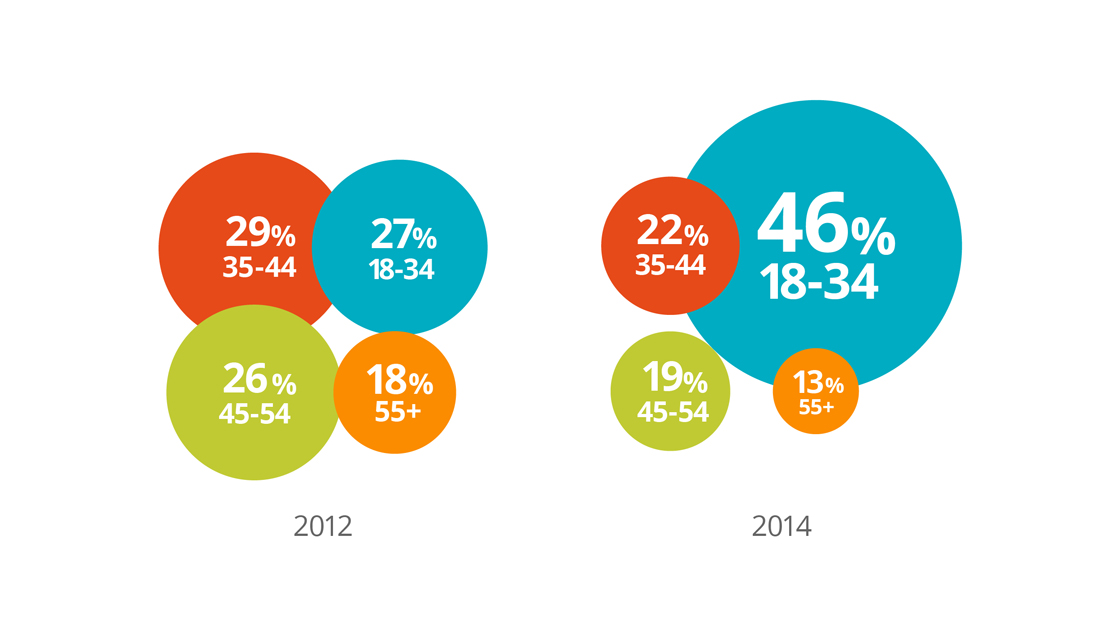
Google/Millward Brown Digital, B2B Path to Purchase Study, 2014.
This generation, known as the millennial generation, is unlike any other that came before it. The oldest members of the group were born around 1980, and that means they've never known a world without the modern-day internet. By the time millennials joined the workforce, half of all Americans were using email regularly, BlackBerrys had been on the market for several years and search engines were already a part of daily life. In other words, millennials are digital natives.
If you're not marketing to this group, you need to reevaluate your strategy, taking into account millennials' familiarity with digital and how this influences the kind of content and media channels they are using.
MYTH #2: B2B marketing should target the highest-level executives
REALITY #2: B2B researchers who are not in the c-suite influence purchase decisions
B2B marketing strategies typically focus exclusively on the C-suite or other senior-level executives. Those strategies won't be nearly as effective today as they were just two years ago. Why? The ecosystem of influencers around the B2B research process has changed—dramatically.
While 64% of the C-suite have final sign off, so do almost a quarter (24%) of the non-C-suite. What's more, it's the latter that has the most influence; 81% of non-C-suiters have a say in purchase decisions. Clearly, if you're marketing only to the highest level, you're overlooking the people who need to notice you. Caterpillar saw this happening and realized it needed to change: "Everything was being done at the C-suite level, but then we found out that new engineers coming on board were just going online and placing orders," says Richardson.
Employee Influence on Purchase Decisions
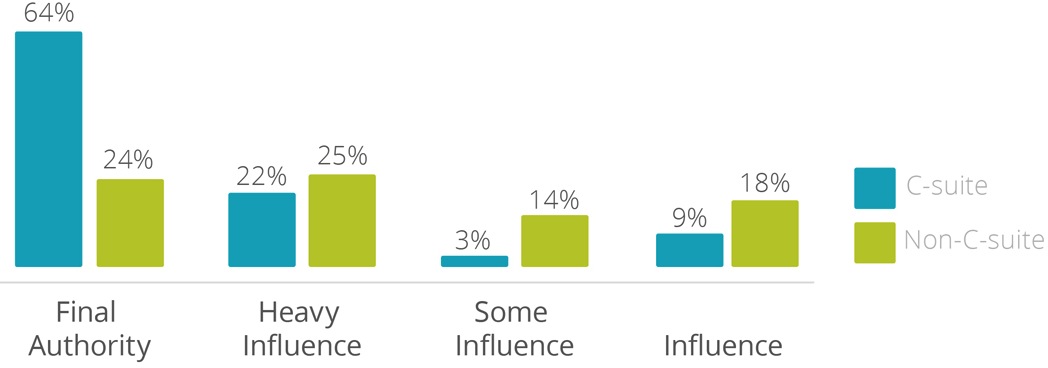
Google/Millward Brown Digital, B2B Path to Purchase Study, 2014.
MYTH #3: Branded searches should be the focus of your search strategy
REALITY #3: 71% of B2B researchers start their research with a generic search
Research shows that those involved in the B2B buying process are already 57% of the way down the path to a decision before they'll actually perform an action on your site. As B2B brands seek new customers, it becomes increasingly important to understand what's happening during this time.
One thing we know is that they're using search. In fact, it's their #1 resource for research; 90% of B2B researchers who are online use search specifically to research business purchases. While that number has remained consistent since the 2012 study, we do see that the way they're searching has changed. The same percentage of people may be using search, but they're spending more time with it. On average, B2B researchers do 12 searches prior to engaging on a specific brand's site.
Average Searches Conducted Prior to Engagement
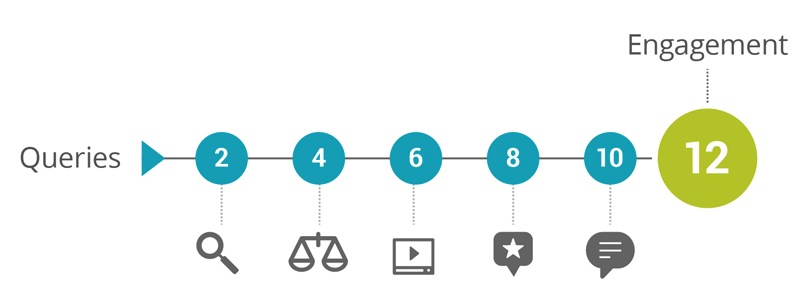
Google/Millward Brown Digital, B2B Path to Purchase Study, 2014.
How are they getting to you? It's an interesting mix—and a telling one—of branded and category searches. About 71% start on a generic query, so they're looking for product first, not for you. Based on data from our Customer Journey tool, we can see that, for large and medium enterprises, generic paid search factors in strongly toward the beginning part of the business/industrial path to purchase.
"What we thought was kind of the traditional purchasing methodology through relationships is actually happening online," says Richardson. "The point of contact with sales comes a lot later, so we have to be well prepared to present our value story to our customers or potential customers much earlier and articulate it in a much simpler manner."
It's not enough just to bid on your brand terms. Influence and decision making are happening earlier on in the purchasing path, even prior to brand awareness. Identify where you can be part of the conversation early on and throughout their searching.
MYTH #4: Not many B2B researchers use mobile
REALITY #4: Mobile usage is intensifying; B2B researchers are using it throughout their entire path
According to the study, 42% of researchers use a mobile device during the B2B purchasing process. Of those, there has been an impressive 91% growth in use over the past two years throughout the entire path (instead of just at the initial stages of research). While there's been only a 6% increase in usage since 2012, it's important to note that the activity of those who do use a smartphone has intensified. As a result, we're seeing a 3X growth in mobile queries.
B2B researchers are not just using mobile when they are out and about, but rather wherever they are. In fact, 49% of B2B researchers who use their mobile devices for product research do so while at work. They're comparing prices, reading about products, comparing feature sets, and contacting retailers. They're purchasing, too; purchase rates on mobile are up 22% in the past two years. Considering the amount of time they're spending on their smartphones, it's important that you provide them with rich mobile experiences.
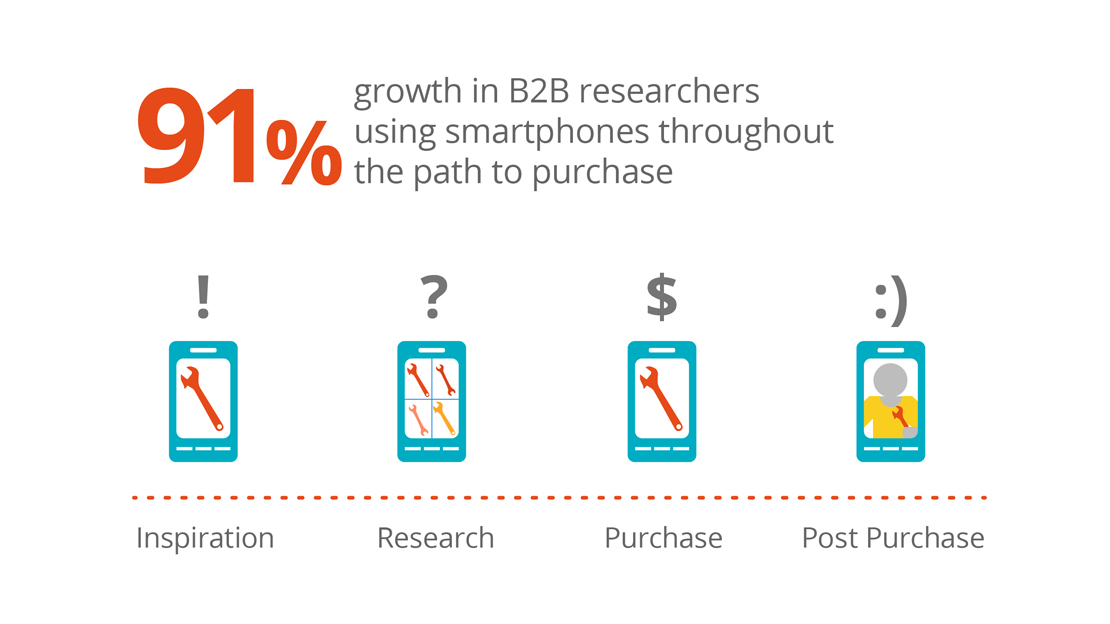
MYTH #5: Video is watched solely to gain awareness
REALITY #5: B2B researchers watch video during the entire path to purchase
Online video is where we've seen the most growth. Seventy percent of B2B buyers and researchers are watching videos throughout their path to purchase. That's a 52% jump in only two years. And it's not just light viewing. According to U.S. YouTube data, over 895K hours of some of the top B2B videos from brands were watched in 2014. Nearly half of these researchers are viewing 30 minutes or more of B2B-related videos during their research process, and almost one in five watch over an hour of content.
Average Watchtime of B2B-Related Videos
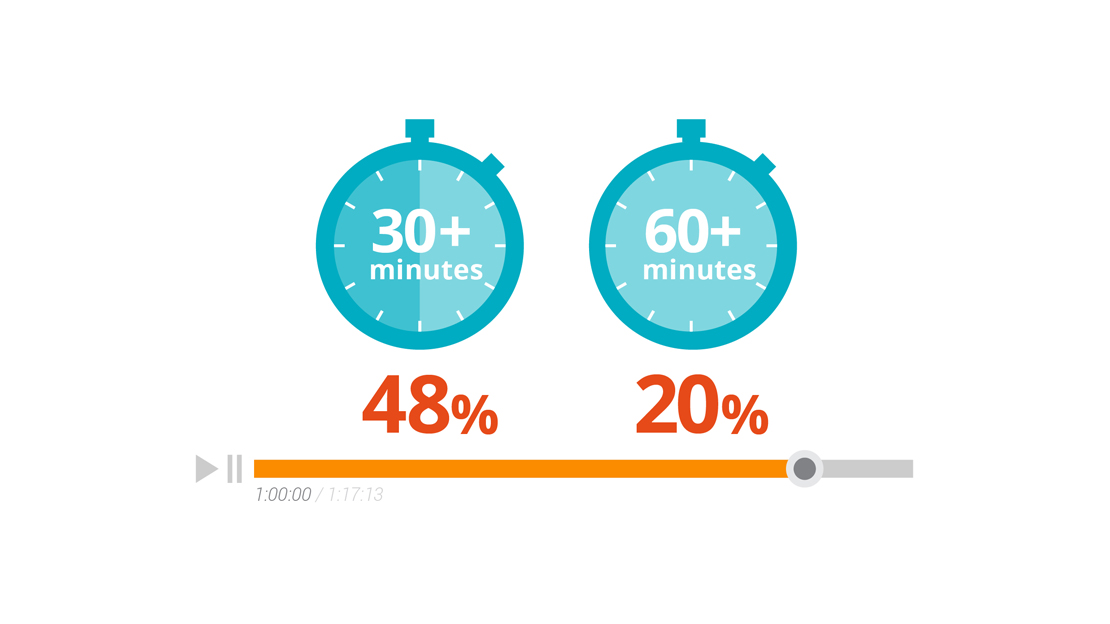
Google/Millward Brown Digital, B2B Path to Purchase Study, 2014.
What's got their attention? Videos about product features top the list, followed by how-tos and professional reviews. They're watching the videos that appear on YouTube because they find them highly useful. These videos are also helping extend the conversation: When asked what they did after watching, B2B researchers said they talked to colleagues, looked for more information, visited a brand's website/store, or shared the video. Start to finish, videos are playing an increasing role for these researchers. That means you need to be producing content that helps them learn about, compare, and research their B2B purchases.
Setting yourself up for success
The most important thing to be thinking about is whether or not you're marketing to this changing audience. B2B influencers are likely younger than expected, and you need to make sure you're reaching them where they are and providing them with the content they're seeking. That means stepping up the intensity in your search, mobile, and video efforts. Delivering content-rich mobile and video experiences is now critical to successfully reaching your B2B customers and moving them through the path to purchase.